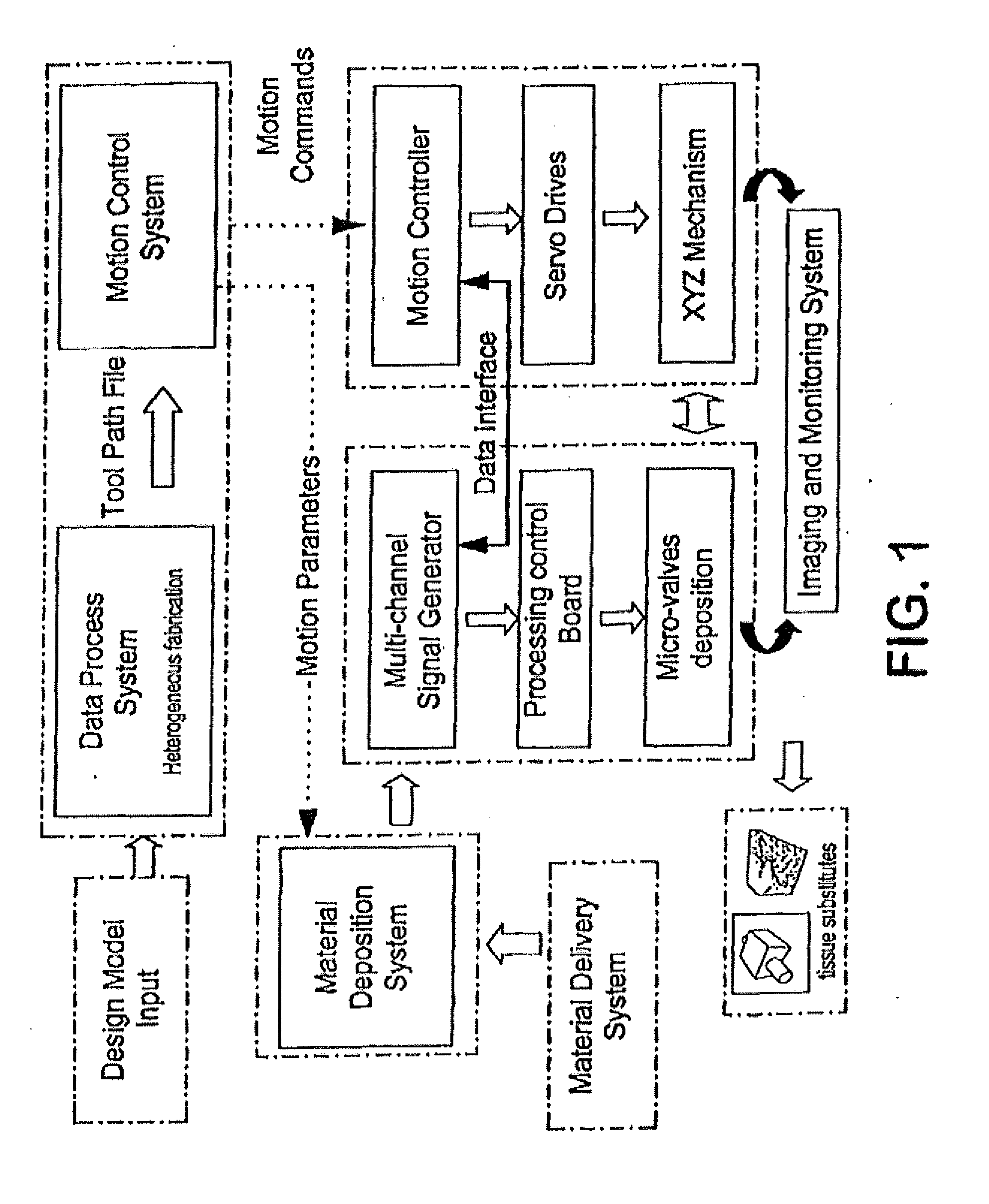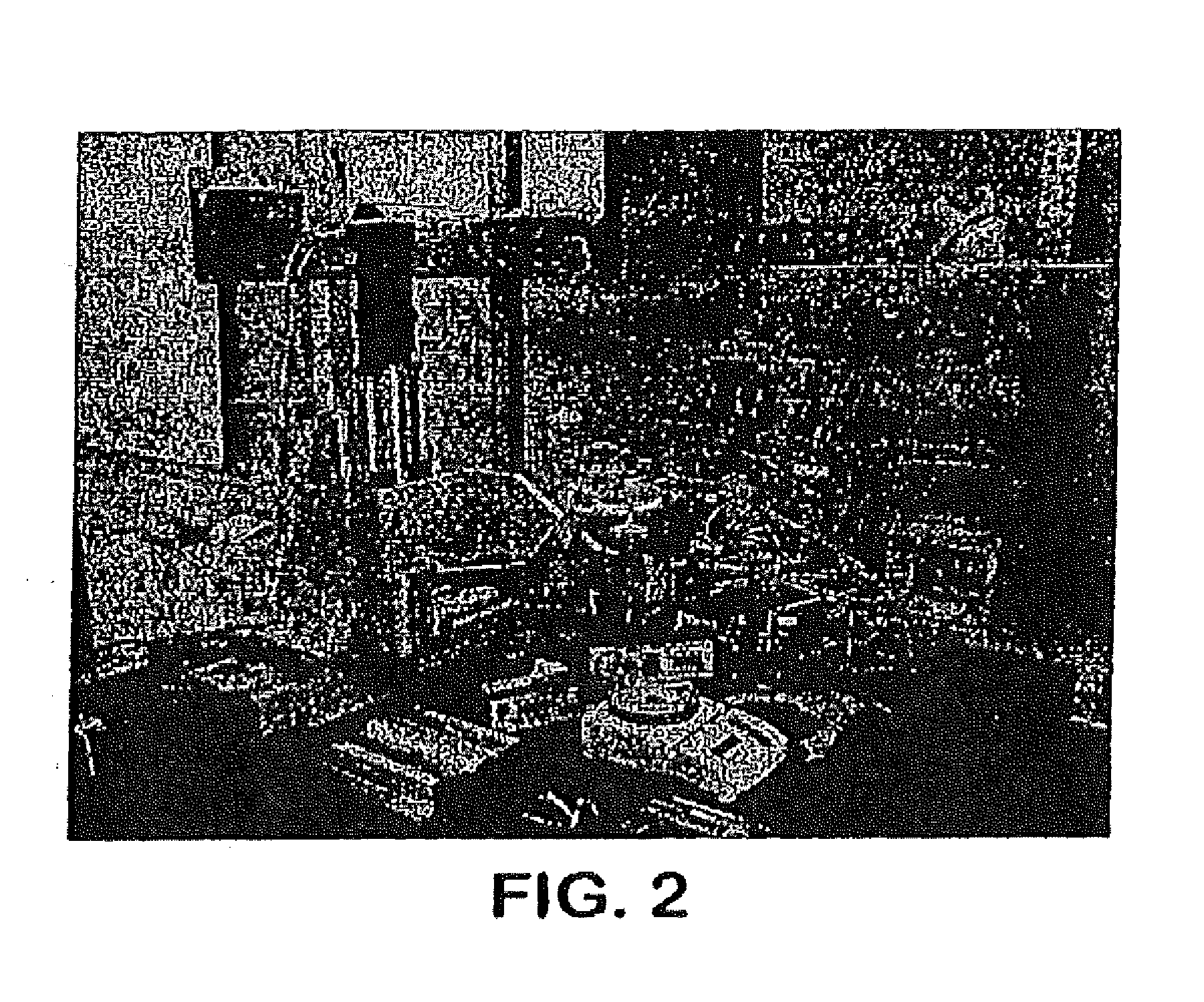Bioprinted Nanoparticles and Methods of Use
- Summary
- Abstract
- Description
- Claims
- Application Information
AI Technical Summary
Benefits of technology
Problems solved by technology
Method used
Image
Examples
experimental examples
[0093]The invention is further described in detail by reference to the following experimental examples. These examples are provided for purposes of illustration only, and are not intended to be limiting unless otherwise specified. Thus, the invention should in no way be construed as being limited to the following examples, but rather, should be construed to encompass any and all variations which become evident as a result of the teaching provided herein.
[0094]The apparatus depicted in FIG. 2 was used to construct various three-dimensional biopolymer based tissue scaffolds. For example, shown in FIG. 7 are, several three-dimensional hydrogel scaffolds (10 layers, calcium alginate), extruded as a 3% (w / v) alginate filament within a cross-linking solution (FIG. 3a) and simple alginate geometrical pattern (FIG. 3b). Depending upon the size of the syringe nozzle, the pressures used, and the type of deposition method (extrusion), alginate filaments within the 30-40 micron range (FIG. 3c) ...
example 1
Nanoparticle Uptake and Cell Viability
[0096]The following materials and methods were used in Example 1.
Chemical Formulation
[0097]Sodium alginate powder (FMCBioPolymer, Drammen, Norway) was dissolved in deionized water at 0.5, 1, 2 and 3% w / v concentrations. An ionic cross-linking solution was prepared by dissolving calcium chloride, CaCl2 (BDH Chemicals, Poole, UK), in deionized water. NanoArc magnetic iron oxide nanoparticles (Alfa Aesar, Ward Hill, Mass.) of 20-40 nm in diameter were used in all experiments. Sodium alginate-magnetic nanoparticle solutions were prepared by vigorously mixing sodium alginate with increasing concentrations of iron oxide nanoparticles to achieve a homogeneous nanoparticle distribution.
Cell Culture
[0098]Porcine aortic endothelial cells (PAEC) were isolated by the collagenase dispersion method and maintained in low glucose Dulbecco's Modified Eagle's medium (DMEM) supplemented with 5% fetal bovine serum, 1% penicillin-streptomycin, and 2% glutamine (Invi...
example 2
Effects of Printing Parameters and Scaffold Properties
[0117]The following materials and methods were used in Example 2.
Scaffold Material
[0118]Sodium alginate powder (FMCBioPolymer, Drammen, Norway) was dissolved in deionized water at 1, 2 and 3% w / v concentrations. An ionic cross-linking solution was prepared by dissolving calcium chloride, CaCl2 (BDH Chemicals, Poole, UK), in deionized water. NanoArc magnetic iron oxide nanoparticles (20-40 nm diameter, Alfa Aesar, Ward Hill, Mass.) were used in all experiments. Sodium alginate-magnetic nanoparticle solutions were prepared by vigorously mixing sodium alginate with increasing concentrations of iron oxide nanoparticles to achieve a homogeneous nanoparticle distribution.
Cell Culture
[0119]PAEC were isolated by the collagenase dispersion method and maintained in low glucose Dulbecco's Modified Eagle's Medium (DMEM) supplemented with 5% fetal bovine serum, 1% penicillin-streptomycin and 2% glutamine (Invitrogen, Carlsbad, Calif.). Cultur...
PUM
| Property | Measurement | Unit |
|---|---|---|
| Diameter | aaaaa | aaaaa |
| Length | aaaaa | aaaaa |
| Length | aaaaa | aaaaa |
Abstract
Description
Claims
Application Information
 Login to View More
Login to View More - R&D
- Intellectual Property
- Life Sciences
- Materials
- Tech Scout
- Unparalleled Data Quality
- Higher Quality Content
- 60% Fewer Hallucinations
Browse by: Latest US Patents, China's latest patents, Technical Efficacy Thesaurus, Application Domain, Technology Topic, Popular Technical Reports.
© 2025 PatSnap. All rights reserved.Legal|Privacy policy|Modern Slavery Act Transparency Statement|Sitemap|About US| Contact US: help@patsnap.com



